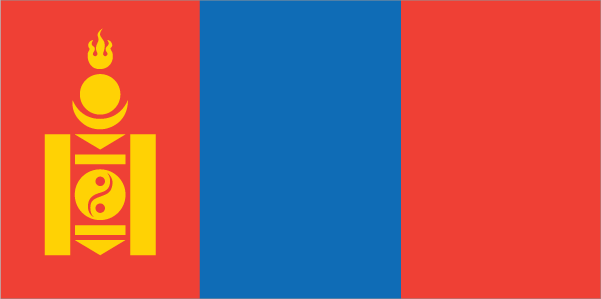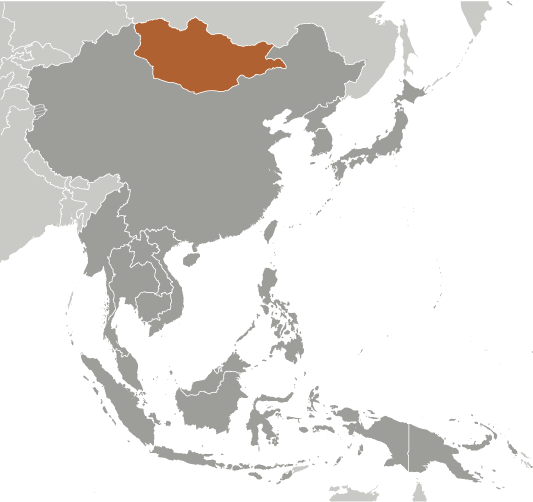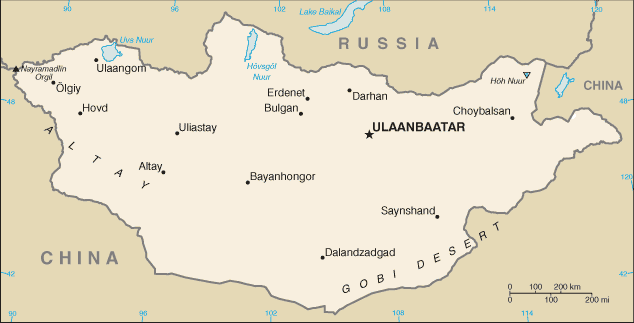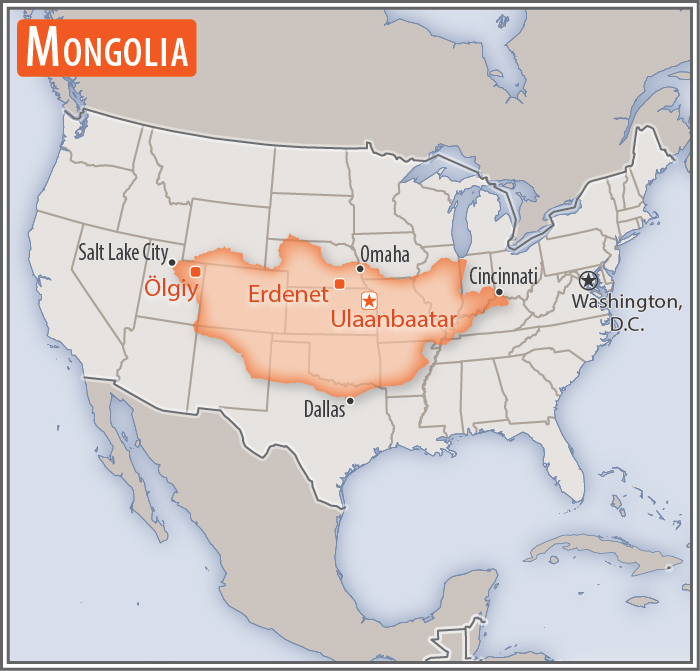Introduction :: MONGOLIA
-
The Mongols gained fame in the 13th century when under Chinggis KHAAN they established a huge Eurasian empire through conquest. After his death the empire was divided into several powerful Mongol states, but these broke apart in the 14th century. The Mongols eventually retired to their original steppe homelands and in the late 17th century came under Chinese rule. Mongolia declared its independence from the Manchu-led Qing Empire in 1911 and achieved limited autonomy until 1919, when it again came under Chinese control. The Mongolian Revolution of 1921 ended Chinese dominance, and a communist regime, the Mongolian People’s Republic, took power in 1924.
The modern country of Mongolia, however, represents only part of the Mongols' historical homeland; today, more ethnic Mongolians live in the Inner Mongolia Autonomous Region in the People's Republic of China than in Mongolia. Since the country's peaceful democratic revolution in 1990, the ex-communist Mongolian People's Revolutionary Party (MPRP) - which took the name Mongolian People’s Party (MPP) in 2010 - has competed for political power with the Democratic Party (DP) and several other smaller parties, including a new party formed by former President ENKHBAYAR, which confusingly adopted for itself the MPRP name. In the country's most recent parliamentary elections in June 2016, Mongolians handed the MPP overwhelming control of Parliament, largely pushing out the DP, which had overseen a sharp decline in Mongolia’s economy during its control of Parliament in the preceding years. Mongolians elected a DP member, Khaltmaa BATTULGA, as president in 2017.
Geography :: MONGOLIA
-
Northern Asia, between China and Russia
46 00 N, 105 00 E
Asia
total: 1,564,116 sq km
land: 1,553,556 sq km
water: 10,560 sq km
country comparison to the world: 20
slightly smaller than Alaska; more than twice the size of Texas
Area comparison map:

East & Southeast Asia
::MONGOLIA

Area Comparison
slightly smaller than Alaska; more than twice the size of Texas
total: 8,082 km
border countries (2): China 4,630 km, Russia 3,452 km
0 km (landlocked)
none (landlocked)
desert; continental (large daily and seasonal temperature ranges)
vast semidesert and desert plains, grassy steppe, mountains in west and southwest; Gobi Desert in south-central
mean elevation: 1,528 m
elevation extremes: lowest point: Hoh Nuur 560 m
highest point: Nayramadlin Orgil (Khuiten Peak) 4,374 m
oil, coal, copper, molybdenum, tungsten, phosphates, tin, nickel, zinc, fluorspar, gold, silver, iron
agricultural land: 73%
arable land 0.4%; permanent crops 0%; permanent pasture 72.6%
forest: 7%
other: 20% (2011 est.)
840 sq km (2012)
sparsely distributed population throughout the country; the capital of Ulaanbaatar and the northern city of Darhan support the highest population densities
dust storms; grassland and forest fires; drought; "zud," which is harsh winter conditions
limited natural freshwater resources in some areas; the policies of former Communist regimes promoted rapid urbanization and industrial growth that had negative effects on the environment; the burning of soft coal in power plants and the lack of enforcement of environmental laws severely polluted the air in Ulaanbaatar; deforestation, overgrazing, and the converting of virgin land to agricultural production increased soil erosion from wind and rain; desertification and mining activities had a deleterious effect on the environment
party to: Biodiversity, Climate Change, Climate Change-Kyoto Protocol, Desertification, Endangered Species, Environmental Modification, Hazardous Wastes, Law of the Sea, Ozone Layer Protection, Ship Pollution, Wetlands, Whaling
signed, but not ratified: none of the selected agreements
landlocked; strategic location between China and Russia
People and Society :: MONGOLIA
-
3,068,243
note: Mongolia is one of the least densely populated countries in the world (2 people per sq km); twice as many ethnic Mongols (some 6 million) live in Inner Mongolia (Nei Mongol) in neighboring China (July 2017 est.)
country comparison to the world: 135
noun: Mongolian(s)
adjective: Mongolian
Khalkh 81.9%, Kazak 3.8%, Dorvod 2.7%, Bayad 2.1%, Buryat-Bouriates 1.7%, Zakhchin 1.2%, Dariganga 1%, Uriankhai 1%, other 4.6% (2010 est.)
Mongolian 90% (official) (Khalkha dialect is predominant), Turkic, Russian (1999)
Buddhist 53%, Muslim 3%, Shamanist 2.9%, Christian 2.2%, other 0.4%, none 38.6% (2010 est.)
0-14 years: 26.95% (male 421,675/female 405,298)
15-24 years: 16.09% (male 249,805/female 243,784)
25-54 years: 45.6% (male 677,679/female 721,435)
55-64 years: 7.07% (male 99,099/female 117,818)
65 years and over: 4.29% (male 53,364/female 78,286) (2017 est.)
population pyramid:

East & Southeast Asia
::MONGOLIA

Population Pyramid
A population pyramid illustrates the age and sex structure of a country's population and may provide insights about political and social stability, as well as economic development. The population is distributed along the horizontal axis, with males shown on the left and females on the right. The male and female populations are broken down into 5-year age groups represented as horizontal bars along the vertical axis, with the youngest age groups at the bottom and the oldest at the top. The shape of the population pyramid gradually evolves over time based on fertility, mortality, and international migration trends.
For additional information, please see the entry for Population pyramid on the Definitions and Notes page under the References tab.
total dependency ratio: 48.5
youth dependency ratio: 42.7
elderly dependency ratio: 5.8
potential support ratio: 17.3 (2015 est.)
total: 28.3 years
male: 27.5 years
female: 29.2 years (2017 est.)
country comparison to the world: 134
1.18% (2017 est.)
country comparison to the world: 93
18.9 births/1,000 population (2017 est.)
country comparison to the world: 88
6.3 deaths/1,000 population (2017 est.)
country comparison to the world: 152
-0.8 migrant(s)/1,000 population (2017 est.)
country comparison to the world: 133
sparsely distributed population throughout the country; the capital of Ulaanbaatar and the northern city of Darhan support the highest population densities
urban population: 73.6% of total population (2017)
rate of urbanization: 2.23% annual rate of change (2015-20 est.)
ULAANBAATAR (capital) 1.377 million (2015)
at birth: 1.05 male(s)/female
0-14 years: 1.04 male(s)/female
15-24 years: 1.02 male(s)/female
25-54 years: 0.94 male(s)/female
55-64 years: 0.85 male(s)/female
65 years and over: 0.69 male(s)/female
total population: 0.96 male(s)/female (2016 est.)
20.5 years
note: median age at first birth among women 20-24 (2008 est.)
44 deaths/100,000 live births (2015 est.)
country comparison to the world: 101
total: 21.1 deaths/1,000 live births
male: 24.2 deaths/1,000 live births
female: 17.9 deaths/1,000 live births (2017 est.)
country comparison to the world: 79
total population: 69.9 years
male: 65.7 years
female: 74.4 years (2017 est.)
country comparison to the world: 160
2.09 children born/woman (2017 est.)
country comparison to the world: 107
54.6% (2013)
4.7% of GDP (2014)
country comparison to the world: 153
2.88 physicians/1,000 population (2011)
6.8 beds/1,000 population (2012)
improved:
urban: 66.4% of population
rural: 59.2% of population
total: 64.4% of population
unimproved:
urban: 33.6% of population
rural: 40.8% of population
total: 35.6% of population (2015 est.)
improved:
urban: 66.4% of population
rural: 42.6% of population
total: 59.7% of population
unimproved:
urban: 33.6% of population
rural: 57.4% of population
total: 40.3% of population (2015 est.)
<.1% (2016 est.)
<500 (2016 est.)
<100 (2016 est.)
20.6% (2016)
country comparison to the world: 96
1.6% (2013)
country comparison to the world: 92
4.6% of GDP (2011)
country comparison to the world: 58
definition: age 15 and over can read and write
total population: 98.4%
male: 98.2%
female: 98.6% (2015 est.)
total: 15 years
male: 14 years
female: 16 years (2015)
total: 17.9%
male: 16.8%
female: 19.4% (2015 est.)
country comparison to the world: 92
Government :: MONGOLIA
-
conventional long form: none
conventional short form: Mongolia
local long form: none
local short form: Mongol Uls
former: Outer Mongolia
etymology: the name means "Land of the Mongols" in Latin; the Mongolian name Mongol Uls translates as "Mongol State"
semi-presidential republic
name: Ulaanbaatar
geographic coordinates: 47 55 N, 106 55 E
time difference: UTC+8 (13 hours ahead of Washington, DC, during Standard Time)
daylight saving time: +1hr, begins last Saturday in March; ends last Saturday in September
note: Mongolia has two time zones - Ulaanbaatar Time (8 hours in advance of UTC) and Hovd Time (7 hours in advance of UTC)
21 provinces (aymguud, singular - aymag) and 1 municipality* (singular - hot); Arhangay, Bayanhongor, Bayan-Olgiy, Bulgan, Darhan-Uul, Dornod, Dornogovi, Dundgovi, Dzavhan (Zavkhan), Govi-Altay, Govisumber, Hentiy, Hovd, Hovsgol, Omnogovi, Orhon, Ovorhangay, Selenge, Suhbaatar, Tov, Ulaanbaatar*, Uvs
29 December 1911 (independence declared from China; in actuality, autonomy attained); 11 July 1921 (from China)
Naadam (games) holiday (commemorates independence from China in the 1921 Revolution), 11-15 July; Constitution Day (marks the date that the Mongolian People's Republic was created under a new constitution), 26 November (1924)
history: several previous; latest adopted 13 January 1992, effective 12 February 1992
amendments: proposed by the State Great Hural, by the president of the republic, by the government, or by petition submitted to the State Great Hural by the Constitutional Court; conducting referenda on proposed amendments requires at least two-thirds majority vote of the State Great Hural; passage of amendments by the State Great Hural requires at least three-quarters majority vote; passage by referendum requires majority participation of qualified voters and a majority of votes; amended 1999, 2001 (2017)
civil law system influenced by Soviet and Romano-Germanic legal systems; constitution ambiguous on judicial review of legislative acts
has not submitted an ICJ jurisdiction declaration; accepts ICCt jurisdiction
citizenship by birth: no
citizenship by descent only: both parents must be citizens of Mongolia; one parent if born within Mongolia
dual citizenship recognized: no
residency requirement for naturalization: 5 years
18 years of age; universal
chief of state: President Khaltmaa BATTULGA (since 10 July 2017)
head of government: Prime Minister Ukhnaa KHURELSUKH (since 4 October 2017); Deputy Prime Minister Ulziisaikhan ENKHTUVSHUN (since 18 October 2017); note - Prime Minister Jargaltulga ERDENEBAT (since 8 July 2016) was voted out of office by the Parliament on 7 September 2017
cabinet: Cabinet nominated by the prime minister in consultation with the president, confirmed by the State Great Hural (parliament)
elections/appointments: presidential candidates nominated by political parties represented in the State Great Hural and directly elected by simple majority popular vote for a 4-year term (eligible for a second term); election last held on 26 June 2017 with a runoff held 9 July 2017 (next to be held in 2021); following legislative elections, the leader of the majority party or majority coalition usually elected prime minister by the State Great Hural
election results: Khaltmaa BATTULGA elected president in second round; percent of vote in first round - Khaltmaa BATTULGA (DP) 38.1%, Miyegombo ENKHBOLD (MPP) 30.3%, Sainkhuu GANBAATAR (MPRP) 30.2%, invalid 1.4%; percent of vote in second round Khaltmaa BATTULGA 55.2%, Miyegombo ENKHBOLD 44.8%
description: unicameral State Great Hural or Ulsyn Ikh Khural (76 seats; members directly elected in single-seat constituencies by simple majority vote; each constituency requires at least 50% voter participation for the poll to be valid; members serve 4-year terms)
elections: last held on 29 June 2016 (next to be held in June 2020)
election results: percent of vote by party - MPP 45.1%, DP 33.1%, MPRP 8.0%, independent 4.8%, other 9.0%; seats by party - MPP 65, DP 9, MPRP 1, independent 1
highest court(s): Supreme Court (consists of the Chief Justice and 24 judges organized into civil, criminal, and administrative chambers); Constitutional Court or Tsets (consists of a chairman and 8 members)
judge selection and term of office: Supreme Court chief justice and judges appointed by the president upon recommendation to the State Great Hural by the General Council of Courts, a 14-member body of judges and judicial officials; term of appointment is for life; chairman of the Constitutional Court elected from among its members; members appointed by the State Great Hural upon nominations - 3 each by the president, the State Great Hural, and the Supreme Court; term of appointment is 6 years; chairmanship limited to a single renewable 3-year term
subordinate courts: aimag (provincial) and capital city appellate courts; soum, inter-soum, and district courts; Administrative Cases Courts
Democratic Party or DP [Sodnomzundui ERDENE]
Mongolian National Democratic Party or MNDP [Bayanjargal TSOGTGEREL]
Mongolian People's Party or MPP [Miyegombo ENKHBOLD]
Mongolian People's Revolutionary Party or MPRP [Nambar ENKHBAYAR]
human rights groups; women's rights groups; disability rights groups
ADB, ARF, CD, CICA, CP, EBRD, EITI (compliant country), FAO, G-77, IAEA, IBRD, ICAO, ICC (NGOs), ICCt, ICRM, IDA, IFAD, IFC, IFRCS, ILO, IMF, IMO, IMSO, Interpol, IOC, IOM, IPU, ISO, ITSO, ITU, ITUC, MIGA, MINURSO, MONUSCO, NAM, OPCW, OSCE, SCO (observer), UN, UNAMID, UNCTAD, UNESCO, UNIDO, UNISFA, UNMISS, UNWTO, UPU, WCO, WHO, WIPO, WMO, WTO
chief of mission: Ambassador (vacant); Charge D’Affaires Bold BAT-OCHR (since 17 September 2017)
chancery: 2833 M Street NW, Washington, DC 20007
telephone: [1] (202) 333-7117
FAX: [1] (202) 298-9227
consulate(s) general: New York, San Francisco
chief of mission:
embassy: Denver Street
mailing address: P.O. Box 341, Ulaanbaatar 14192
telephone: [976] 7007-6001
FAX: [976] 7007-6016
three, equal vertical bands of red (hoist side), blue, and red; centered on the hoist-side red band in yellow is the national emblem ("soyombo" - a columnar arrangement of abstract and geometric representation for fire, sun, moon, earth, water, and the yin-yang symbol); blue represents the sky, red symbolizes progress and prosperity
soyombo emblem; national colors: red, blue, yellow
name: "Mongol ulsyn toriin duulal" (National Anthem of Mongolia)
lyrics/music: Tsendiin DAMDINSUREN/Bilegiin DAMDINSUREN and Luvsanjamts MURJORJ
note: music adopted 1950, lyrics adopted 2006; lyrics altered on numerous occasions
Economy :: MONGOLIA
-
Foreign direct investment in Mongolia's extractive industries – which are based on extensive deposits of copper, gold, coal, molybdenum, fluorspar, uranium, tin, and tungsten - has transformed Mongolia's landlocked economy from its traditional dependence on herding and agriculture. Exports now account for more than 40% of GDP. Mongolia depends on China for more than 60% of its external trade - China receives some 90% of Mongolia's exports and supplies Mongolia with more than one-third of its imports. Mongolia also relies on Russia for 90% of its energy supplies, leaving it vulnerable to price increases. Remittances from Mongolians working abroad, particularly in South Korea, are significant.
Soviet assistance, at its height one-third of GDP, disappeared almost overnight in 1990 and 1991 at the time of the dismantlement of the USSR. The following decade saw Mongolia endure both deep recession, because of political inaction, and natural disasters, as well as strong economic growth, because of market reforms and extensive privatization of the formerly state-run economy. The country opened a fledgling stock exchange in 1991. Mongolia joined the WTO in 1997 and seeks to expand its participation in regional economic and trade regimes.
Growth averaged nearly 9% per year in 2004-08 largely because of high copper prices globally and new gold production. By late 2008, Mongolia was hit by the global financial crisis and Mongolia's real economy contracted 1.3% in 2009. In early 2009, the IMF reached a $236 million Stand-by Arrangement with Mongolia and it emerged from the crisis with a stronger banking sector and better fiscal management. In October 2009, Mongolia passed long-awaited legislation on an investment agreement to develop the Oyu Tolgoi (OT) mine, among the world's largest untapped copper-gold deposits. However, a dispute with foreign investors developing OT called into question the attractiveness of Mongolia as a destination for foreign investment. This caused a severe drop in FDI, and a slowing economy, leading to the dismissal of Prime Minister ALTANKHUYAG in November 2014. The economy had grown more than 10% per year between 2011 and 2013 - largely on the strength of commodity exports and high government spending - before slowing to 7.8% in 2014, and falling to the 2% level in 2015 through 2017, even though government spending remained high.
The May 2015 agreement with Rio Tinto to restart the OT mine and the subsequent $4.4 billion finance package signing in December 2015 stemmed the loss of investor confidence. The current government has made restoring investor trust and reviving the economy its top priority, but has failed to invigorate the economy in the face of the large dropoff in foreign direct investment, mounting external debt, and a sizeable budget deficit. However, Mongolia reached staff-level agreement with the IMF in February 2017 on an Extended Fund Facility program, and once approved by the IMF Board, the program is expected to improve Mongolia’s long-term fiscal and economic stability.
$38.4 billion (2017 est.)
$37.63 billion (2016 est.)
$37.27 billion (2015 est.)
note: data are in 2017 dollars
country comparison to the world: 120
$10.87 billion (2016 est.)
2% (2017 est.)
1% (2016 est.)
2.4% (2015 est.)
country comparison to the world: 175
$12,600 (2017 est.)
$12,500 (2016 est.)
$12,600 (2015 est.)
note: data are in 2017 dollars
country comparison to the world: 121
29.3% of GDP (2017 est.)
25.9% of GDP (2016 est.)
21.1% of GDP (2015 est.)
country comparison to the world: 65
household consumption: 51.9%
government consumption: 13.7%
investment in fixed capital: 21.7%
investment in inventories: 4.1%
exports of goods and services: 70.8%
imports of goods and services: -62.1% (2017 est.)
agriculture: 13.2%
industry: 36.1%
services: 50.7% (2017 est.)
wheat, barley, vegetables, forage crops; sheep, goats, cattle, camels, horses
construction and construction materials; mining (coal, copper, molybdenum, fluorspar, tin, tungsten, gold); oil; food and beverages; processing of animal products, cashmere and natural fiber manufacturing
6.1% (2017 est.)
country comparison to the world: 171
1.24 million (2016 est.)
country comparison to the world: 137
agriculture: 31.1%
industry: 18.5%
services: 50.5% (2016)
8% (2017 est.)
7.9% (2016 est.)
country comparison to the world: 107
21.6% (2014 est.)
lowest 10%: 13.8%
highest 10%: 8.8% (2016)
36.5 (2008)
32.8 (2002)
country comparison to the world: 85
revenues: $2.623 billion
expenditures: $3.711 billion (2017 est.)
24.1% of GDP (2017 est.)
country comparison to the world: 117
-10% of GDP (2017 est.)
country comparison to the world: 210
91.4% of GDP (2017 est.)
90% of GDP (2016 est.)
country comparison to the world: 25
calendar year
4.4% (2017 est.)
0.6% (2016 est.)
country comparison to the world: 71
12% (14 January 2016 )
13% (15 January 2015)
country comparison to the world: 15
19.9% (31 December 2017 est.)
19.74% (31 December 2016 est.)
country comparison to the world: 15
$1.109 billion (31 December 2017 est.)
$839.6 million (31 December 2016 est.)
country comparison to the world: 158
$6.257 billion (31 December 2017 est.)
$4.851 billion (31 December 2016 est.)
country comparison to the world: 127
$9.406 billion (31 December 2017 est.)
$7.326 billion (31 December 2016 est.)
country comparison to the world: 115
$632.6 million (31 December 2015 est.)
$766.1 million (31 December 2014 est.)
$1.095 billion (31 December 2013 est.)
country comparison to the world: 110
-$532 million (2017 est.)
-$700 million (2016 est.)
country comparison to the world: 110
$5.676 billion (2017 est.)
$4.804 billion (2016 est.)
country comparison to the world: 106
copper, apparel, livestock, animal products, cashmere, wool, hides, fluorspar, other nonferrous metals, coal, crude oil
China 84.1%, UK 6.8% (2016)
$4.196 billion (2017 est.)
$3.466 billion (2016 est.)
country comparison to the world: 136
machinery and equipment, fuel, cars, food products, industrial consumer goods, chemicals, building materials, cigarettes and tobacco, appliances, soap and detergent
China 33.2%, Russia 25.6%, South Korea 8.6%, Japan 7% (2016)
$22.28 billion (31 December 2017 est.)
$19.79 billion (31 December 2016 est.)
country comparison to the world: 92
$19.42 billion (31 December 2017 est.)
$16.28 billion (31 December 2016 est.)
country comparison to the world: 84
$475.2 million (31 December 2017 est.)
$455.2 million (31 December 2016 est.)
country comparison to the world: 92
togrog/tugriks (MNT) per US dollar -
2,378.1 (2017 est.)
2,140.3 (2016 est.)
2,140.3 (2015 est.)
1,970.3 (2014 est.)
1,817.9 (2013 est.)
Energy :: MONGOLIA
-
population without electricity: 300,000
electrification - total population: 90%
electrification - urban areas: 98%
electrification - rural areas: 73% (2013)
5.192 billion kWh (2015 est.)
country comparison to the world: 121
5.785 billion kWh (2015 est.)
country comparison to the world: 116
51 million kWh (2015 est.)
country comparison to the world: 86
1.427 billion kWh (2015 est.)
country comparison to the world: 61
1.106 million kW (2015 est.)
country comparison to the world: 126
94.9% of total installed capacity (2015 est.)
country comparison to the world: 54
0% of total installed capacity (2015 est.)
country comparison to the world: 136
0% of total installed capacity (2015 est.)
country comparison to the world: 186
5.1% of total installed capacity (2015 est.)
country comparison to the world: 96
23,430 bbl/day (2016 est.)
country comparison to the world: 65
14,360 bbl/day (2014 est.)
country comparison to the world: 56
0 bbl/day (2014 est.)
country comparison to the world: 156
0 bbl (1 January 2017)
country comparison to the world: 163
0 bbl/day (2014 est.)
country comparison to the world: 169
26,000 bbl/day (2015 est.)
country comparison to the world: 127
0 bbl/day (2014 est.)
country comparison to the world: 176
24,380 bbl/day (2014 est.)
country comparison to the world: 109
0 cu m (2013 est.)
country comparison to the world: 164
0 cu m (2013 est.)
country comparison to the world: 203
0 cu m (2013 est.)
country comparison to the world: 144
0 cu m (2013 est.)
country comparison to the world: 151
0 cu m (1 January 2014 es)
country comparison to the world: 167
14 million Mt (2013 est.)
country comparison to the world: 94
Communications :: MONGOLIA
-
total subscriptions: 225,287
subscriptions per 100 inhabitants: 7 (July 2016 est.)
country comparison to the world: 125
total: 3,367,573
subscriptions per 100 inhabitants: 111 (July 2016 est.)
country comparison to the world: 139
general assessment: network is improving with international direct dialing available in many areas; a fiber-optic network has been installed that is improving broadband and communication services between major urban centers with multiple companies providing inter-city fiber-optic cable services
domestic: very low fixed-line teledensity; there are four mobile-cellular providers and subscribership is increasing
international: country code - 976; satellite earth stations - 7 (2016)
following a law passed in 2005, Mongolia's state-run radio and TV provider converted to a public service provider; also available are 69 radio and 131 TV stations, including multi-channel satellite and cable TV providers; transmissions of multiple international broadcasters are available (2017)
.mn
total: 674,949
percent of population: 22.3% (July 2016 est.)
country comparison to the world: 131
Transportation :: MONGOLIA
-
number of registered air carriers: 3
inventory of registered aircraft operated by air carriers: 12
annual passenger traffic on registered air carriers: 541,129
annual freight traffic on registered air carriers: 7,130,148 mt-km (2015)
JU (2016)
44 (2013)
country comparison to the world: 98
total: 15
over 3,047 m: 2
2,438 to 3,047 m: 10
1,524 to 2,437 m: 3 (2017)
total: 29
over 3,047 m: 2
2,438 to 3,047 m: 2
1,524 to 2,437 m: 24
under 914 m: 1 (2013)
1 (2013)
total: 1,815 km
broad gauge: 1,815 km 1.520-m gauge
note: national operator Ulaanbaatar Railway is jointly owned by the Mongolian Government and by the Russian State Railway (2016)
country comparison to the world: 76
total: 49,249 km
paved: 4,800 km
unpaved: 44,449 km (2013)
country comparison to the world: 79
580 km (the only waterway in operation is Lake Hovsgol) (135 km); Selenge River (270 km) and Orhon River (175 km) are navigable but carry little traffic; lakes and rivers ice free from May to September) (2010)
country comparison to the world: 81
total: 261
by type: bulk carrier 8, container ship 5, general cargo 101, oil tanker 67, other 80 (2017)
country comparison to the world: 58
Military and Security :: MONGOLIA
-
0.92% of GDP (2016)
0.87% of GDP (2015)
0.86% of GDP (2014)
0.82% of GDP (2013)
0.92% of GDP (2012)
country comparison to the world: 90
Mongolian Armed Forces (Mongol ulsyn zevsegt huchin): Mongolian Army, Mongolian Air Force (2016)
18-27 years of age for compulsory and voluntary military service; 1-year conscript service obligation in army or air forces or police for males only; after conscription, soldiers can contract into military service for 2 or 4 years; citizens can also voluntarily join the armed forces (2017)
Transnational Issues :: MONGOLIA
-
none
stateless persons: 14 (2016)















